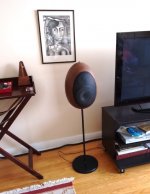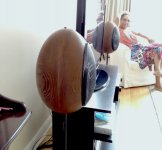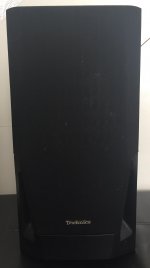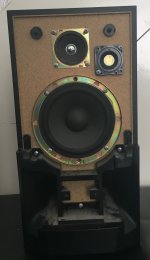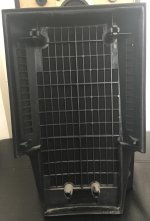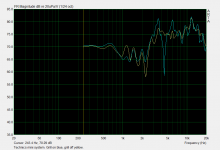Asymmetry may not "solve" the problem, but as your second paragraph states, it does make it less offensive.
Hi Earl,
Do you think instead of roundover on waveguide, the diffraction/reflection problem can be equally addressed the following way when the waveguide is mounted in free air?
1) A sawtoothed edged waveguide
2) A wave edged waveguide as in http://www.gramophones.info/gramophones.picbig.hmv.7.jpg, just increase the waviness
3) An assymetric waveguide, something like the yellow one in https://imgur.com/0M9Gt5J.jpg
Thanks
All it really does is moves the "least offensive" response from being somewhat off axis to on axis.
But now the off axis response that was previously least offensive is now more offensive. So you're only making the response on one axis better by making other axes worse.
Also most people do not listen directly on axis but listen about 10-15 degrees off axis anyway when they toe their speakers to cross in front or behind the listener.
You make a good first point that asymmetry will only significantly affect on-axis and that most of us don't listen on-axis.
But I don't accept you second paragraph at face-value because, to me, it seems wrong. You would have to prove it for me to accept it. To me it seems that all axes get "more smeared", but none get "worse". Why would they be "worse"?
You may be misleading with this statement. Edge rounding will also 'smear' diffraction in time and space, and it makes best use of the baffle area. It is always about having enough to reduce the effects below perception - either way. Centring the source may focus resonances on axis, but if they are below perception? When the speaker has been deliberately designed for a centred source and isn't trying to make some sort of compromise, then...
By worse, I might accept specifically 'stronger', but there can be other reasons for accepting this. I know that speaker/room placement works when modes are spread via placement, but I think this is good advice for speakers that were not made to work specifically with a room at lower frequencies rather than a blanket statement.
I think you misunderstood the quoted comment as it was directed at "drivers" not "enclosures".
Hi Earl,
Do you think instead of roundover on waveguide, the diffraction/reflection problem can be equally addressed the following way when the waveguide is mounted in free air?
1) A sawtoothed edged waveguide
2) A wave edged waveguide as in http://www.gramophones.info/gramophones.picbig.hmv.7.jpg, just increase the waviness
3) An assymetric waveguide, something like the yellow one in https://imgur.com/0M9Gt5J.jpg
Thanks
1) will smear the diffraction, but not really reduce its energy. Free standing waveguides are always a bad idea as the edge diffraction is always bad unless the edge is slowly wrapped back around to the rear - like an enclosure.
2) same answer as above.
3) I have done this and the square mouth does smear the diffraction, but it does not reduce it. Only a larger round-over will actually reduce the total energy. It is unclear to me if a smeared diffraction is less offensive than a non-smeared one, but lower total energy certainly is.
Diffraction...?
What diffraction?
B.
Everything has some diffraction. The edge of the grill on that device will diffract.
Edge...?Everything has some diffraction. The edge of the grill on that device will diffract.
What edge?*
B.
*OK, maybe just a little edge. These were early production models from Leigh Instruments. Innards are sort of like Rogers/BBC LS3/5A with the usual 18-piece crossover, ferrofluids, bass-boost option, protective circuit breakers, and a bunch of mounting options....
Attachments
Last edited:
But in terms of spousal-approval factor, they will blend in nicely with a decor that is poultry themed.then there's the ultimate in bad highly audible diffraction...the oblate spheriod waveguide!
B.
Or fans of Mork & Mindy loldecor that is poultry themed.
But in terms of spousal-approval factor, they will blend in nicely with a decor that is poultry themed.
B.
Hard boiled or soft ?
C.M
Last edited:
The frame of the grill. If you follow a line from the driver along the face of the front panel towards the edge of the grill it will hit the frame and diffract there.Edge...?
What edge?*
It's actually pretty hard to make a grill whose frame doesn't cause any diffraction, as by definition it's going to have to have a frame to support it, and that frame is going to obstruct the propagation of any sound travelling along the baffle. (Absorption around the edge of the frame may be the only way)
Which is one reason why my speakers have removable grills - grills are on for casual listening like watching TV to protect the speakers against my 2 year old but they come off for serious listening when he's otherwise occupied...
Last edited:
Well DBMandrake, it would be no trouble at all for you to post evidence about the influence your snap-on grill has on the freq response. Just a before-and-after test with a single mic position would be a good move to validating your views. Takes no time....It's actually pretty hard to make a grill whose frame doesn't cause any diffraction... Which is one reason why my speakers have removable grills - grills are on for casual listening like watching TV...
As much as your long posts contain your subjective opinions, frankly, I'd like to see you post traces of the speaker with and without the grill so we can assess your claims for ourselves.
B.
There are two effects from adding the grill cloth, one is a gradual rolling off of the high frequencies from the cloth material of the grill - it's not huge, but it's definitely quite audible as it changes the balance between upper midrange and top end treble, and sounds just like turning a conventional treble control down a little...Well DBMandrake, it would be no trouble at all for you to post evidence about the influence your snap-on grill has on the freq response. Just a before-and-after test with a single mic position would be a good move to validating your views. Takes no time.
This could be measured with a single on axis measurement. However the effects of diffraction can't be adequately measured by a single on axis measurement as the diffraction is a 3D phenomenon that will affect the response in different axes different ways.
As for takes no time, yeah, right.
I've tried before and the result you get is garbage because you can't get sufficient reflection free time which means either all kinds of reflections and diffraction from nearby objects or such a short gate time that you can't go sufficiently low in frequency.
To make meaningful measurements I'd need to clear out the dining room, mount the speaker on a tall stand near the middle of the room and set up a proper measurement environment, which is anything but "takes no time".
I did do this back before I designed the crossovers so that I would have adequately accurate measurements to use in the design process, however I had not constructed the grill cloths at the time, they came later.
I do plan to do a full set of polar measurements of the completed speakers and I will be sure to do both grills on and grills off, but it's just a matter of finding the time to do it and the opportunity to take over an entire room for a couple of days to do all the various measurements I want in one go.
Please feel free to post measurements of your own!As much as your long posts contain your subjective opinions, frankly, I'd like to see you post traces of the speaker with and without the grill so we can assess your claims for ourselves.
Surely you own some speakers with grills ? According to you it takes no time, so it should be easy, right ?
Wordy nonsense....However the effects of diffraction can't be adequately measured by a single on axis measurement as the diffraction is a 3D phenomenon that will affect the response in different axes different ways....
Please feel free to post measurements of your own!...
A single pair of measurements will immediately show if there is any effect at all and will defend you from an accusation that you are just blowing hot air with your claim that you hear it.
BTW, in response to my challenging your views, your snide comment ("Please feel free...") that I should go test your claim for you is offensive.
B.
Setting up a proper measurement environment to get accurate meaningful measurements that are free from the effects of room reflections is challenging as I have to convert a family room that is in active use into a speaker measurement environment.Wordy nonsense.
A single pair of measurements will immediately show if there is any effect at all and will defend you from an accusation that you are just blowing hot air with your claim that you hear it.
This is not trivial for me to do and I will not be doing it just to satisfy some guy on a forum who likes to troll me.
I am not going to take half arsed measurements with the speakers in-situ that I know will be hopelessly inaccurate due to the influence of nearby objects, nor will I publicly post such half arsed measurements. When I get around to performing properly controlled measurements whose accuracy and validity I'm happy with I am happy to post them.
"Exceptional claims demand exceptional proof". That means that whoever is arguing on the side that goes against generally accepted science is the one that burden of proof falls onto.BTW, in response to my challenging your views, your snide comment ("Please feel free...") that I should go test your claim for you is offensive.
It's not my job to prove to you that the earth is an oblate spheroid, or that F=ma. These kind of things are well proven. Someone that wants to dispute things like that needs to provide their own proof.
As far as I'm concerned its your claim that the grill frame doesn't introduce diffraction that is the exceptional claim that demands proof, not my claim that it does, like all other edges and discontinuities, cause diffraction.
Most of us here understand what baffle edge diffraction does, the frame of a grill is just another impediment to the propagation of the sound wave that causes yet another source of diffraction, and often quite a bad one that can be worse than a naked sharp edged baffle on it's own.
Some things can be done to minimise the effects but it's not a trivial challenge to produce a removable grill that has no diffraction effects - as I said earlier, I'm not even sure it's possible other than using a lot of absorption to absorb the wave along the baffle before it gets to the frame, or perhaps using fairly directional drivers.
I don't have grill / no grill measurements of my current speakers, but I have performed these comparisons on many other speakers in the past, so I'm not just blowing hot air as you put it. In fact I took some recent measurements of a cheap pair of Technics speakers at the same time I took my driver measurements for my crossover design.
They are a small pair of crappy mini-system speakers that I had been listening to while my main speakers were having their cabinets and crossovers redesigned, and I was curious to see how bad they measured, as they sound pretty average and I had never measured them before.
The first measurement I did with the grill on (light blue line on the graph) was so horrific in the treble, with up to 20dB variations, that I did a double take and thought there was something wrong with my measurement setup, windowing time etc.... but nope, that's how bad they measure.
I then removed the grill to see how much of that was diffraction effects from the admittedly very intrusive grill design and you can see the difference in the yellow line from 3Khz upwards which is dramatically flatter, although still not great. The peaks at 3.5Khz and 6Khz are gone, as is the deep notch at 4.5Khz. Not surprisingly they sound a lot smoother in the treble with the grill off!
The hole in the midrange from 600Hz to 3Khz appears to be down to a dreadful crossover design which not only doesn't match the driver sensitivities but also seems to have phase cancellation problems at the crossover frequency as well! Not a good speaker, although I have certainly heard worse speakers in the same category.
Now granted if you look at the photos of the speaker it's pretty much a worst case scenario when it comes to diffraction either with the grills off or on, and perhaps a case study of how not to design a low diffraction speaker... With them off the plastic port tubes at the bottom remain causing a large source of diffraction for the woofer, none of the drivers are flush mounted, the edge of the box actually has a lip, and so on.
Looking at the back of the grills they wrap right around and have plastic ribbing covering most of the area of the grill, so they won't just be diffracting at the edge.
But this is an actual measurement of a real life, commercial speaker to illustrate just how badly a grill can affect the response, and not made up "hot air".
The grills on my speakers are a different design - they are flat, there is no reinforcement ribbing in the middle, it's purely just a flat sheet of fabric pulled tight by an outside rectangular frame, so there shouldn't be any diffraction from close proximity to the driver like there is on the Technics, the only diffraction will be from the frame at the edge, so far less severe than exhibited by this Technics speaker.
The frame is actually spaced about 5mm away from the panel rather than touching it, but whether that's better or worse for diffraction I'm not actually sure without taking measurements both ways, but there are certainly speakers that deliberately space the frame of grills away from the panel a bit.
As my tweeter uses a small wave-guide this should reduce the effects of grill edge diffraction significantly as well, but I'm sure there will still be some diffraction occurring at the edge of the grill, and there is definitely some high frequency attenuation caused by the material of the grill cloth itself.
Attachments
Last edited:
Wordy nonsense.
A single pair of measurements will immediately show if there is any effect at all and will defend you from an accusation that you are just blowing hot air with your claim that you hear it.
BTW, in response to my challenging your views, your snide comment ("Please feel free...") that I should go test your claim for you is offensive.
B.
Agree. No issue and easy to measure tweeter response in a normal room.
What makes you think grill edge diffraction only affects the tweeters frequency range on a 39cm wide 59cm tall baffle ? On that size baffle it will have effects far below the tweeter's operating range.Agree. No issue and easy to measure tweeter response in a normal room.
Even with the speaker up on a stand in the middle of a room the longest reflection free time window I can get for measurements is about 4.2ms which only provides a resolution of about 300Hz.
Where the speakers normally sit in the living room near other objects the reflection free time is well under 2ms, perhaps 1.5ms making any such measurements pretty useless, especially when the whole point of the exercise is to find diffraction effects belonging to the speaker itself and its grill, not nearby objects right beside the speakers!
So sorry, I don't agree with your comment - there is no point taking measurements if their validity is completely questionable. I see enough poorly taken measurements on this forum already by people that don't understand how to properly perform a windowed measurement that is free from room effects that I am not going to add to them with obviously dubious measurements that prove nothing.
Bogus measurements are worse than no measurements at all. When I get the chance to take some suitable measurements I will. Until then you'll have to take your own!
Last edited:
As we can see in post #135 example, grill diffractions induce changes above 500Hz, mainly above 1kHz. Indoor measurement at 1m on-axis, IR gating 4-5ms is totally valid and easy to perform to verify diffractions of baffle/grille. Baffle step range influences are minimal because of long wavelength. This kind of measurement shows always some other reflections, but we are investigating only the difference here.
The grille/mask/front cover is pretty tricky to make acoustically tranasparent and non-reflective. My guess is that the optimal construction is a curved metal mesh and it's frame set in a groove in the baffle (like in many tweeters, but in maxi-size!
Grill frame diffraction effects on frequency response
Some commercial speakers are smoother with the grille on! Avalon Acoustics Indra loudspeaker Measurements | Stereophile.com
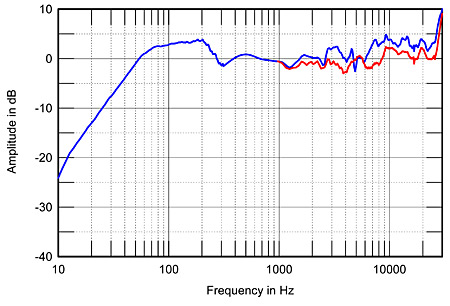
The grille/mask/front cover is pretty tricky to make acoustically tranasparent and non-reflective. My guess is that the optimal construction is a curved metal mesh and it's frame set in a groove in the baffle (like in many tweeters, but in maxi-size!
Grill frame diffraction effects on frequency response
Some commercial speakers are smoother with the grille on! Avalon Acoustics Indra loudspeaker Measurements | Stereophile.com

Simon is correct (I think Ben is just being difficult), one could not do any reasonable measurement in-situ. There will be too many nearby wall and other diffractions/reflections to get any decent idea of the grills effect. But it is well known that grills are a problem in general. That's why I never used them.
Simon is correct (I think Ben is just being difficult), one could not do any reasonable measurement in-situ. There will be too many nearby wall and other diffractions/reflections to get any decent idea of the grills effect. But it is well known that grills are a problem in general. That's why I never used them.
Earl - is seems self-evident to some others posting here that before-and-after measurements - even just a single run of the sort DBMandrake posted - definitely illustrate the extent of grill influence on FR, if present, even if they don't tell the story in 100 charts.
Of course, the grill plot DBManddrake shows is the worse grill ever designed by humankind since approximately the year Homer was born. Have a close look at the picture.
And using 1/24 smoothing might show differences in the treble even a fly landed on the grill before the run, if I may exaggerate a bit.
And somebody might wonder why the two curves don't superimpose perfectly below say 750 Hz like they seem to when I repeat runs quickly together.
Now that's only FR.
Anybody who has done real-world FR traces knows that some plots, sims, and phenomena (like comb filtering or other phase stuff) that look profoundly horrible are not audibly detectable except when special test tones are used, if then.
DRMandrake here and in other places has made astonishing claims for his hearing perception. So I'd still like to see human tests of diffraction detection. And if there is some sense of shortcoming when diffraction is present, does it take more than a bit of felt or proper asymmetry to make it undetectable.
Human tests... that's the R&D we need.
B.
Human tests... that's the R&D we need.
B.
So, have you read the ones that we did? They were pretty conclusive that diffraction is audible and that its audibility increases with increasing SPL. This means that one will ALWAYS hear it at some SPL (if the loudspeaker can take that much SPL without other major problems.)
In my experience lowering diffraction leads to better sound quality. I not only do it in the speaker designs, but in the room itself. Diffraction off of the TV or equipment stands is no different than that from the loudspeaker itself.
- Status
- This old topic is closed. If you want to reopen this topic, contact a moderator using the "Report Post" button.
- Home
- Loudspeakers
- Multi-Way
- Baffle Diffraction
